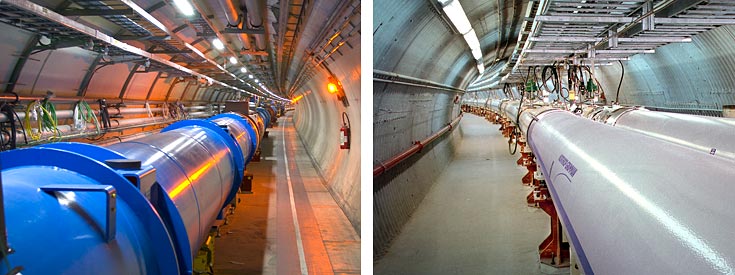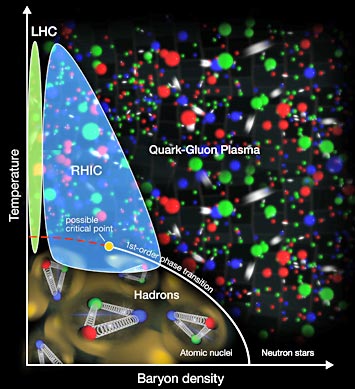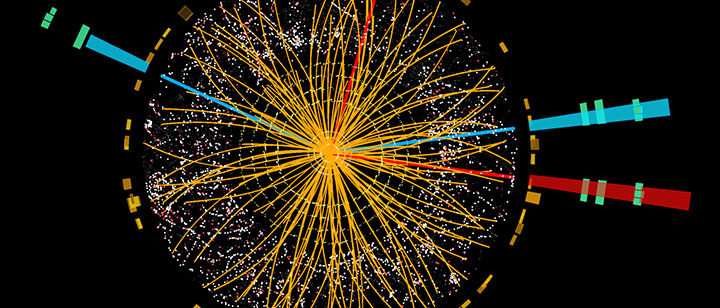Connections to Research at Brookhaven’s Relativistic Heavy Ion Collider (RHIC)

Superconducting magnets of the Large Hadron Collider (left) and Brookhaven's Relativistic Heavy Ion Collider (right).
While the LHC spends most of its time colliding protons for experiments that explore questions in high-energy particle physics, a smaller portion of its running time is devoted to heavy ion collisions of interest to nuclear physicists. Analyses of particles streaming from these collisions at ATLAS and two other LHC experiments, ALICE and CMS, are directly complementary with the nuclear physics research program at Brookhaven's Relativistic Heavy Ion Collider (RHIC). The healthy competition and collaboration among scientists at these facilities, with some Brookhaven physicists working on nuclear physics research at both facilities, has greatly enhanced the exploration of nuclear matter—the inner cogs that make up the nucleus, and really, everything around us.
On the most basic level, scientists know that the nucleus is made of particles called protons and neutrons, which are made of smaller particles called quarks and gluons—the most fundamental constituents of matter. They know that the quarks are grouped into triplets held together by gluons (named for their Elmer's-like properties). But, they also know that these elementary particles weren't always glued together. Go back about 13.7 billion years, a millionth of a second after the Big Bang, and you'd find quarks and gluons floating freely. And that's where it gets sticky—or actually, kind of fluid.
RHIC was the first machine built to collide heavy ions (nuclei of heavy atoms stripped of their electrons) to recreate this moment in history, in microcosm. What scientists have found in these collisions was a stunning surprise. Instead of producing a gas of free quarks and gluons, RHIC's energetic collisions produce something more like a liquid—a four-trillion-degree-Celsius "perfect" liquid with almost no viscosity, or frictional resistance to flow. Subsequent heavy-ion collisions at the LHC have confirmed the liquid nature of this quark-gluon plasma, created at even higher energies and temperatures.
While LHC has a lock on access to the highest-energy explorations of quark-gluon plasma, RHIC's ability to collide a wide range of ion species over a very wide range of energies gives physicists access to studying the transition that takes place from quark-gluon plasma to ordinary nuclear matter. For instance, it appears that the fluid at the higher temperatures at the LHC is less perfect than that at RHIC, as expected for matter deep in the quark-gluon plasma phase. Understanding in detail how the properties of matter evolve with temperature close to and away from the transition may offer insight into the analogous transition that took place in our infant universe to form the first protons, neutrons, and atoms. Physicists from both facilities agree that the combined energy range of RHIC and the LHC is needed to fully explore and understand the critical properties of the plasma.

RHIC's exploration of the "nuclear phase diagram" shows signs of a sharp border—a first-order phase transition—between the hadrons that make up ordinary atomic nuclei and the quark-gluon plasma (QGP) of the early universe when the QGP is produced at relatively low energies / temperatures. The data may also suggest a possible critical point, where the type of transition changes from the abrupt, first-order kind to a continuous crossover at higher energies. The LHC explores QGP at even higher energies.
The heavy-ion research programs at RHIC and the LHC are together mapping out points on the so-called phase diagram of nuclear matter. A phase diagram shows the boundaries between different types of the same substance as external conditions, such as pressure and temperature, change. One of the best-known phase diagrams illustrates what happens to water as it freezes in an ice cube tray or turns to steam while boiling in a pot on the stove. For nuclear matter, the phase diagram aims to show the boundary between normal matter, composed of compact neutrons and protons, and a system of liberated quarks and gluons.
Of particular interest to nuclear physicists is the location of a "critical point," a threshold of temperature and quark density above which there is no sharp transition between two phases. On one side of the critical point associated with nuclear matter, there is an obvious difference between normal matter and a substance of unconfined quarks and gluons, and the transition from one phase to the other is sharp. But on the other side, the two phases can coexist and the transition from one to the other is a smooth crossover. Collisions at RHIC over a wide range of energies changes not only the temperature but also the composition of the plasma—the relative amount of quarks and their antimatter counterparts. Studying those details is helping physicists zero in on the critical point, which many physicists feel is essential to understanding how quarks and gluons work together over large volumes to form the perfect liquid. Data on both sides of the critical point can reveal a great deal about the fundamental processes that have produced the matter we see in our universe today.

ATLAS detector event display showing a Higgs candidate event.
There's even a connection between the LHC's discovery of the Higgs particle, which imparts mass to elementary particles, and the heavy ion programs at RHIC and the LHC. While the Higgs particle is responsible for the mass of fundamental particles such as quarks, the three valence quarks that make up each proton account for only about one percent of its total mass. Where does the rest of the mass of these more complex building blocks come from?
The answer, physicists believe, lies in how the quarks interact via the exchange of gluons, massless particles that hold the quarks together via nature's strongest force, and interactions among the gluons themselves. To tease apart the features of this force, which gets stronger and stronger if you try to pull the subatomic quarks apart, physicists accelerate atomic nuclei (a.k.a. heavy ions) to near light speed, where the gluons become dominant, and then steer them into head-on collisions at RHIC and the LHC.
Because these collisions recreate conditions that last existed early in the universe, before quarks joined up to form protons and neutrons, they give scientists an opportunity to study the behavior of "free" quarks and gluons in the primordial quark-gluon plasma. Those studies should help scientists better understand the strong force, and how it generates so much of the mass of the visible matter in the universe—everything made of atoms, from stars to planets to people.
While visible matter accounts for a mere fraction of the total universe—just five percent, the rest being composed of dark matter and mysterious dark energy—it's enough to keep heavy ion physicists busy for awhile!
Read more about how RHIC explores the gluon fields, and a possible new collider designed with this research as one of its main goals.


